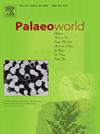江西省张树市二叠纪(五家坪纪)已知最古老的弯蝶科(半翅目)
IF 1.7
3区 地球科学
Q2 PALEONTOLOGY
引用次数: 0
摘要
Sinocurvicubitus qingjiangensis n. gen. n. sp.根据江西清江盆地乐平组崂山段的蝉甲,于1984年建立,是curvicutidae科最早记录。该新分类群的特征为脉R在基部1/3顶尖处分叉,脉M在基部2/3处凹陷,脉M在节线上先分叉,脉M较发达,脉CuA较不发达。这一新发现不仅扩大了曲丘类动物在中国已知的古地理分布范围,而且表明曲丘类动物起源于古生代。这一新的记录,结合其他的曲丘虫科记录,表明该科在晚二叠世至晚三叠世期间可能同时向北和向南迁移和分散。本文章由计算机程序翻译,如有差异,请以英文原文为准。
The oldest known Curvicubitidae (Hemiptera) from the Permian (Wuchiapingian) of Zhangshu City, Jiangxi Province, southern China
As the earliest record of the family Curvicubitidae Hong, 1984, Sinocurvicubitus qingjiangensis n. gen. n. sp. is established based on a cicada tegmen collected from the Laoshan Member of the Leping Formation in the Qingjiang Basin, Jiangxi Province, southern China. This new taxon is characterised by vein R forked at basal 1/3rd tegminal length, indentation at basal 2/3rds length, vein M first forked on nodal line, more developed M and less developed CuA. A Wuchiapingian age for this new species is suggested by the co-occurrence of the ammonoids Araxoceras tricarinatus and Pseudogastrioceras sp. The new find not only extends the known palaeogeographical range of curvicubitids in China, but also suggests an origin of this family in the Palaeozoic. This new record, combined with other records of Curvicubitidae, suggests a possibility of simultaneously northward and southward migration and dispersal of this family during the late Permian to the Late Triassic.
求助全文
通过发布文献求助,成功后即可免费获取论文全文。
去求助
来源期刊

Palaeoworld
PALEONTOLOGY-
CiteScore
4.00
自引率
5.90%
发文量
95
期刊介绍:
Palaeoworld is a peer-reviewed quarterly journal dedicated to the study of past life and its environment. We encourage submission of original manuscripts on all aspects of palaeontology and stratigraphy, comparisons of regional and global data in time and space, and results generated by interdisciplinary investigations in related fields. Some issues will be devoted entirely to a special theme whereas others will be composed of contributed articles. Palaeoworld is dedicated to serving a broad spectrum of geoscientists and palaeobiologists as well as serving as a resource for students in fields as diverse as palaeobiology, evolutionary biology, taxonomy and phylogeny, geobiology, historical geology, and palaeoenvironment.
Palaeoworld publishes original articles in the following areas:
•Phylogeny and taxonomic studies of all fossil groups
•Biostratigraphy, chemostratigraphy, chronostratigraphy
•Palaeoecology, palaeoenvironment and global changes throughout Earth history
•Tempo and mode of biological evolution
•Biological events in Earth history (e.g., extinctions, radiations)
•Ecosystem evolution
•Geobiology and molecular palaeobiology
•Palaeontological and stratigraphic methods
•Interdisciplinary studies focusing on fossils and strata
 求助内容:
求助内容: 应助结果提醒方式:
应助结果提醒方式:


